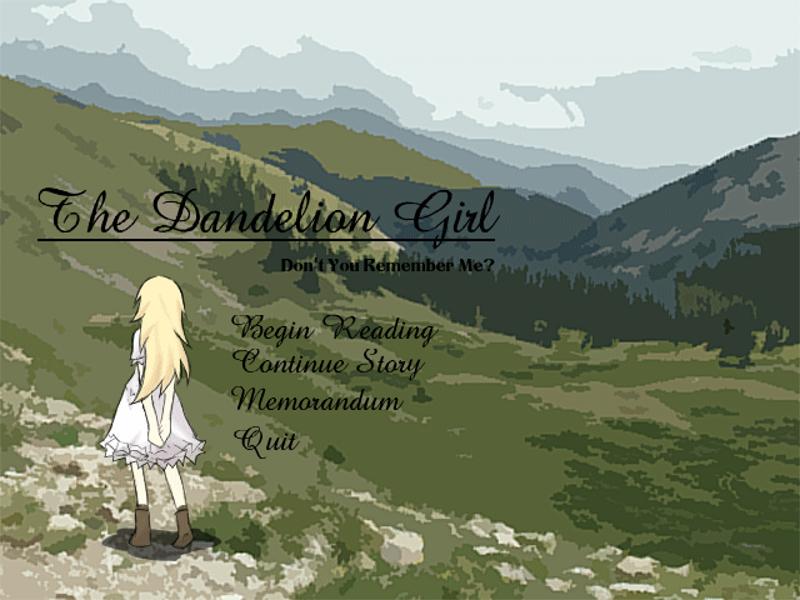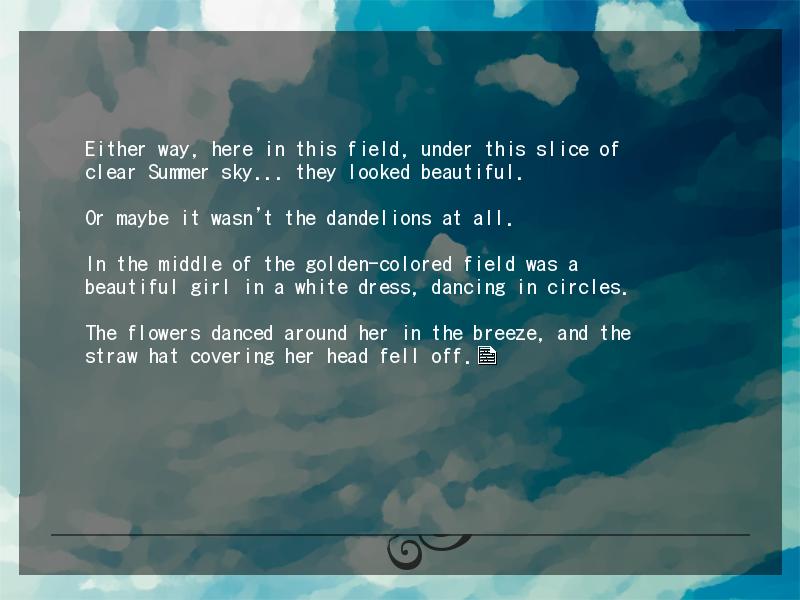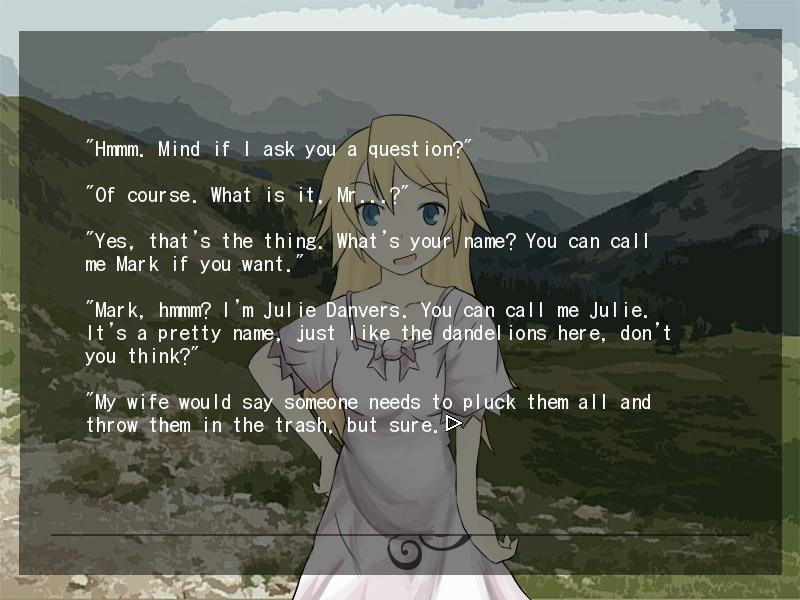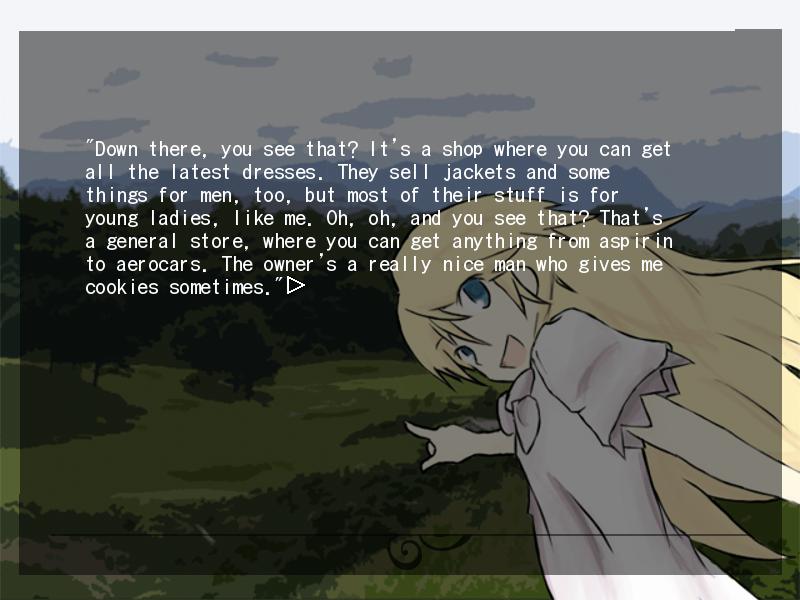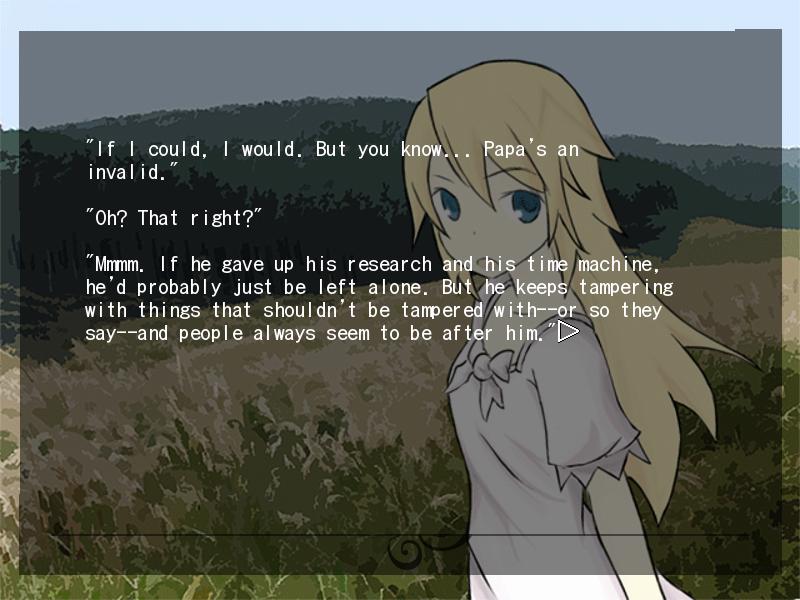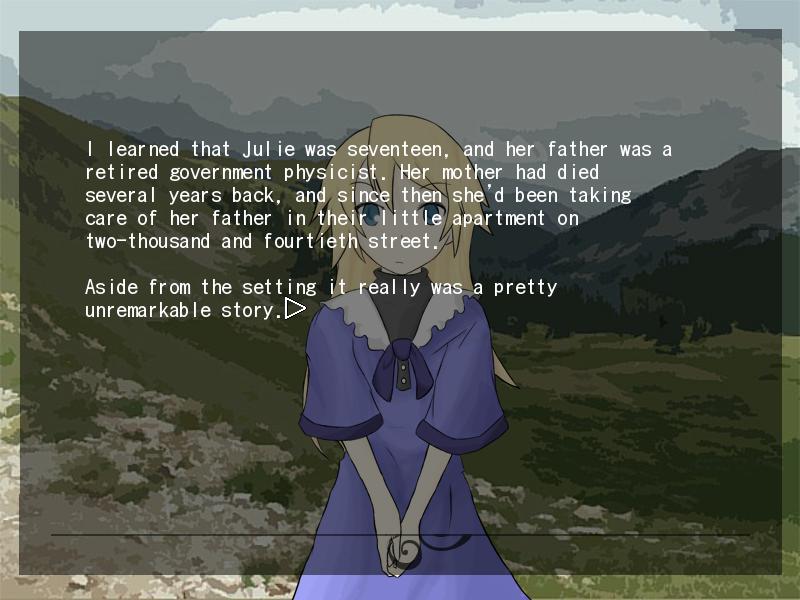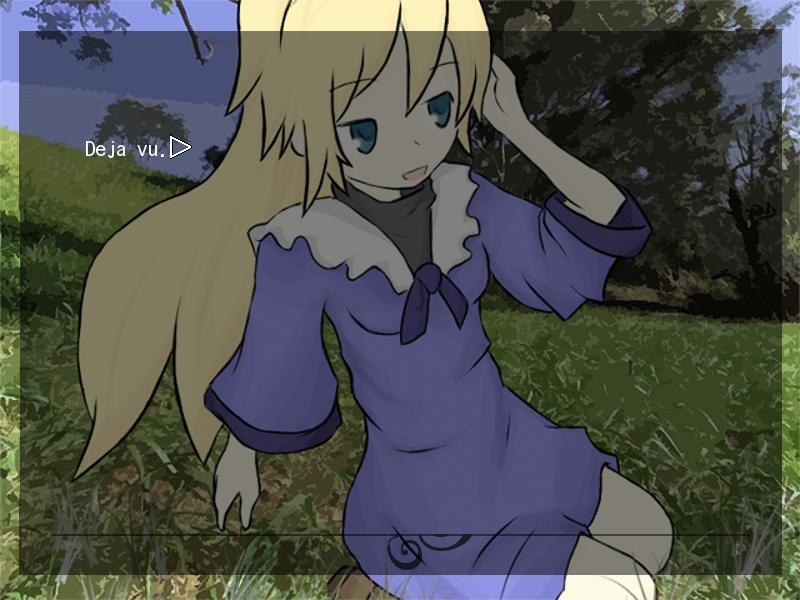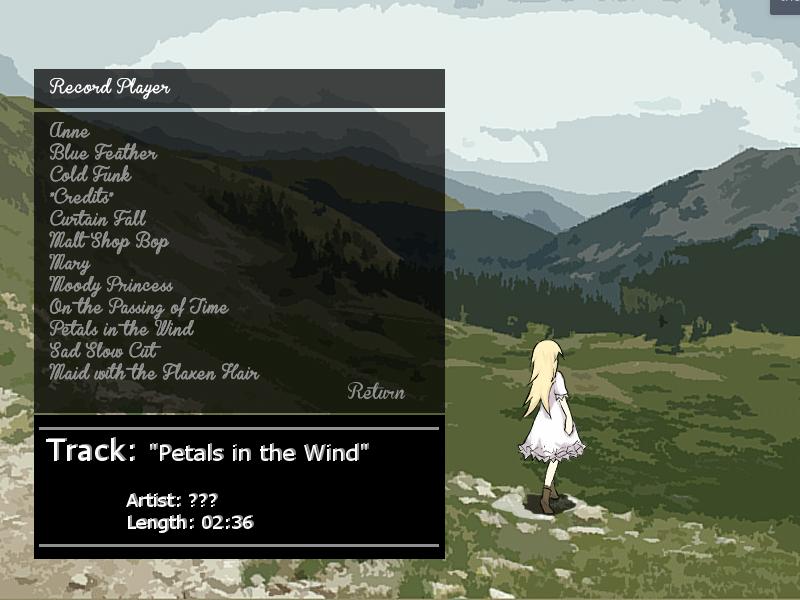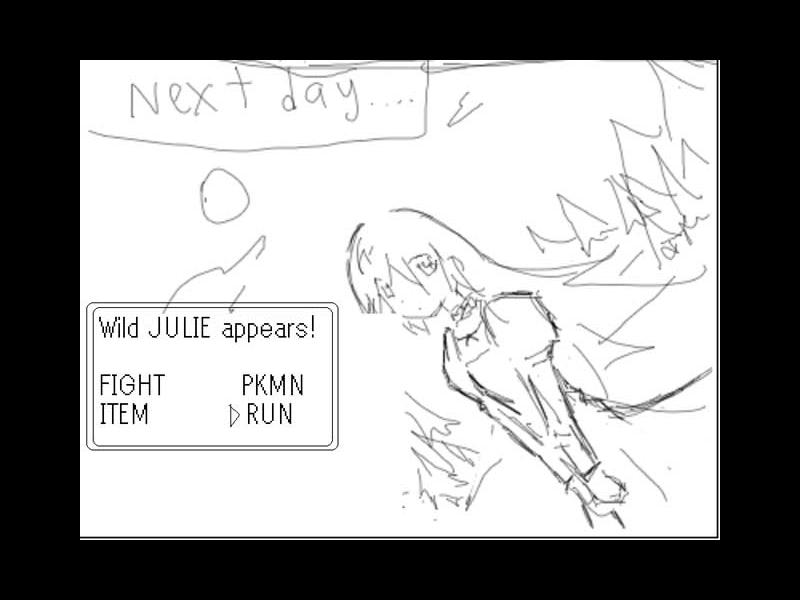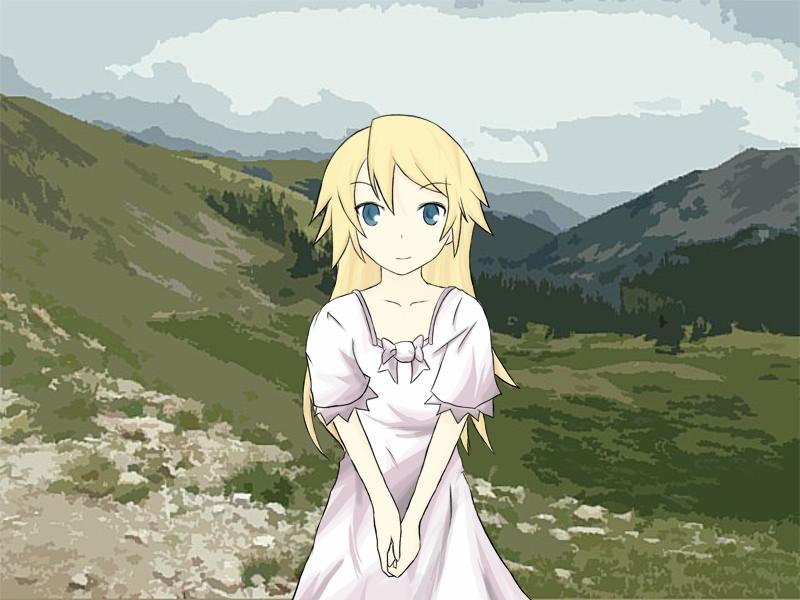On February 19, 2010, a group of individuals under the banner of /jp/ project created a freeware English-language visual novel, written in ONScripter, titled The Dandelion Girl (sometimes listed as The Dandy Girl). Science fiction fans may notice that the novel shares a name with a 1961 short story by Robert F. Young called The Dandelion Girl. This is no mere coincidence, for The Dandelion Girl visual novel was an adaptation Young’s The Dandelion Girl in short kinetic visual novel form. The original Dandelion Girl visual novel website went offline not too long after the novel was published and I have not tracked down a copy of the 2010 novel. Fortunately, one of the individuals involved in the creation of the first Dandelion Girl visual novel has released a re-make with a revised script and numerous new sprites and backgrounds on August 28, 2016, titled The Dandelion Girl: Don’t You Remember Me? The 2016 Dandelion Girl, like the 2010 original, is written in ONScripter and freely available. Unlike the original, it is available for download on both Steam and Itch.io, making it easy to discover and run. Both versions of the novel are included in the Visual Novel Database entry for The Dandelion Girl.
Below, I will review the 2016 version of The Dandelion Girl visual novel in the largely spoiler-free format in which I write my visual novel reviews. After discussing the history of the project and my thoughts on the novel, I will offer some notes about how the visual novel adaptation of Robert F. Young’s short story compares to the short story. Note that I read the short story after reading the visual novel.
(For those who are interested, you can read Robert F. Young’s short story here or in PDF form. That archived link comes courtesy of Wikipedia’s page about the short story.)
The Dandelion Girl Details
The Dandelion Girl was first made available in 2010 on the website of Ed Michaels, who I believe was the lead developer. There, he presented the novel as Dandy Girl. The website is no longer live but you can view an archived capture of the website here. Mr. Michaels noted he was not the sole developer, writing that most other developers who worked on the project “chose to remain anonymous.”
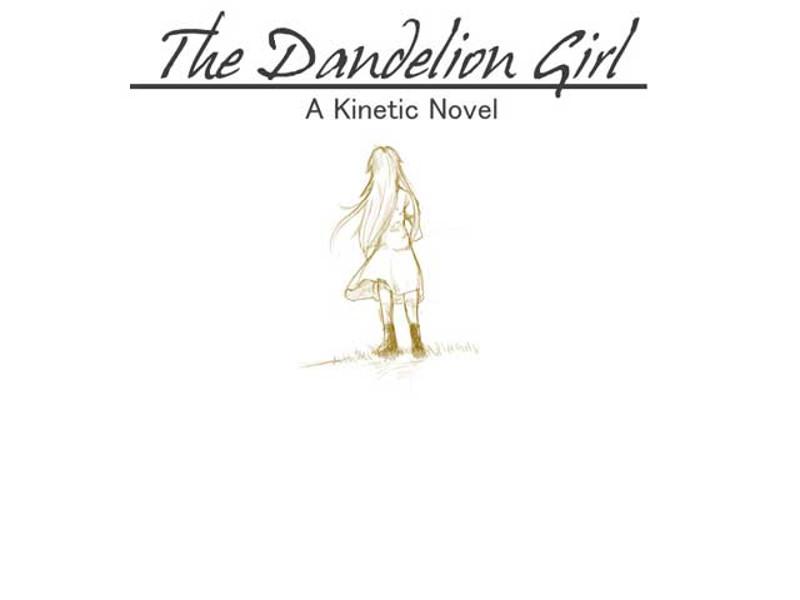
As I noted in the introduction, I have not been able to track down a copy of the original 2010 Dandelion Girl. The novel was originally uploaded to Megaupload and the download link appears to have already been defunct by 2011 or 2012. Visual Novel Database refers readers to the website of a French translation of Dandy Girl which once included a download link for the original English novel, but that link also no longer works.
On August 28, 2016, one of the original developers of Dandy Girl released an updated version of the novel called The Dandelion Girl: Don’t You Remember Me? This developer posted as SteinersCooking89 (heretofore “SC89”) on the Lemmasoft Forums on August 30, 2016, to make visual novel fans aware of the re-release (see forum post). SC89 was part of the original Dandy Girl team and decided to remake the novel around 2014. Because the original Dandy Girl artist was not interested in participating, the remake “ended up being more of a revamp and a rewrite.” See a list of changes and what remains the same as described by SC89 below:
- “The sprites and CGs are the same”
- “[A]ll the menus have been remade”
- “[T]he script is rewritten”
- “[T]here’s an additional scene added which makes use of a CG the artist provided which I never got around to using.”
One reason I was interested in finding the original was so I could compare the two scripts, but that will have to be a future project.
Today, The Dandelion Girl, 2016 version, is available for free on Steam and Itch.io, published by Outis Media.
(It can also be downloaded from the forum thread I linked to previously.)
The Dandelion Girl stands out in Outis Media’s collection of original English visual novels. Its other offerings include titles such as Monster Girl Brothel Sim Prototype, Indecent Occupations of Monster Girls, and numerous other novels that appear to follow the same general theme. Unlike these other pieces, Dandelion Girl is entirely family friendly and safe for work.
I originally discovered The Dandelion Girl from a source I have used often for other visual novel reviews: Kaisernet’s list of ONScripter games in English. Regular readers will know that I wrote full reviews of 29 English translations of freeware Japanese visual novels that were completed and released as part of three “al|together festivals” from 2005-2008 (pre-dating even the original 2010 Dandelion Girl). Most of these visual novels were originally written using NScripter, a proprietary freeware Japanese visual novel engine. The English localizations made use of ONScripter, an open source implementation of NScripter, but English-focused versions thereof (which were early versions of what evolved into ONScripter-EN). Kaisernet has a very good list of English NScripter/ONScripter games (including all of the ONScripter al|together releases). Many have direct download links. With just a few exceptions, the novels on the list are English versions of Japanese games. The Dandelion Girl: Don’t You Remember Me? is one of the two original English-language visual novels on the list. While ONScripter itself can support non-Japanese games and ONScripter-EN as well as forks thereof (namely PONScripter) are in development, ONScripter is not a popular engine/language for original English-language novels (“OELVN”). Given how much I have written about ONScripter-EN localizations of NScripter games, I was interested in adding a genuine OELVN written in ONScripter to my review collection.
Running The Dandelion Girl
(Note: The following section is written for people who are downloading the visual novel from Itch.io or the original forum post. For those of you using Steam, the novel should run on Windows and Linux (via Proton for Linux) without ever needing to touch the files. The Steam version is DRM-free.)
The Dandelion Girl comes as a zip file with a Windows executable. Regular readers will know that I run Linux and while I can easily run Windows NScripter and ONScripter games on top of WINE, I prefer to run them natively on Linux where possible. As I discussed in an article on extracting the contents of some of the al|together ONScripter game installers, it is usually possible to run ONScripter/ONScripter-EN games on Linux even in cases where they do not come with a Linux executable, provided that you supply an up-to-date Linux version of ONScripter-EN.
The Readme for The Dandelion Girl advises “Mac and Linux Users” to go to a specific website to download the latest build of ONScripter for their operating system. However, the link in the Readme is broken. I have ONScripter installed on my computer, but I am not as familiar with using upstream ONScripter as I am with ONScripter-EN, which is currently being maintained by Galladite27 on GitHub. I had just used the new 2024-07-21 Linux release of ONScripter-EN to run May Sky, a 2008 localization of an NScripter novel, so I tried running the same executable in the directory for The Dandelion Girl. I happily report that it worked perfectly as far as I could tell. Thus, I recommend that Linux users who want to run the novel natively use the newest ONScripter-EN build from GitHub (or 2024-07-21 if some future version has an unexpected issue) to run The Dandelion Girl as an alternative to running it with WINE. (I do not use MacOS and I know that ONScripter-EN has issues on ARM-based Macs, so I am not sure if there is an ONScripter version that works on newer Mac computers for running the novel without WINE or using a helper like PlayOnMac).
The Dandelion Girl Overview
Note that this general overview is based solely on The Dandelion Girl: Don’t You Remember Me? visual novel. If you have read the short story, you will likely notice a few differences.
The view-point character in The Dandelion Girl is a man named Mark. He is a middle-aged lawyer. We meet him while he is on vacation in the countryside. Mark had planned to go on vacation with his wife, Anne, and his college-aged son. However, his wife was unable to accompany him because she had been selected for jury duty, and his son had already left as planned on account of school. Left alone, Mark hiked to a certain hilltop where his attention was arrested by the site of a teenage girl in a white dress in a field of dandelions with hair that was “a shade or two darker than the dandelions around her.”
Feeling lonely, Mark struck up a conversation with the girl in the white dress. She introduced herself as Julie Danvers and turned out to be engaging, sharing with him her love of dandelions and the field. The girl surprised Mark, however, when she stated with all seriousness that she had come to his time-period from 240 years in the future. Mark did not believe it – chalking it up to the whimsy of a young lady – but he played along for reasons unknown to him. Speaking of things unknown to Mark – he had a strange feeling of deja vu when he first set eyes on the girl — but he could not quite put a finger on what it was. But regardless of the strange feeling, he greatly enjoyed his time with Julie and the feeling was mutual.
Oh, oh! You know, the day before yesterday I saw a rabbit, and yesterday a deer, and today, you.
Julie Danvers (The Dandelion Girl visual novel)
Mark told Julie about his own circumstances – that his family vacation plans were thwarted by Anne’s jury duty. Julie teased Mark about Anne not accompanying him,bragged about the fine material her dress was made from (Mark noted it was unusual), and the time machine her father had built. They parted with a promise to meet on that hilltop again the next day.
Mark would indeed meet Julie the next day and a couple of times thereafter. They engaged in more friendly conversation. We learned that Julie was 17 and the visual novel takes place in 1966. Mark told Julie more about his family, including little details like how his wife refused to have her picture taken, and their past. Julie explained how time travel worked (not that Mark was necessarily buying it, but he played along), they discussed books they had both read, and gazed at the clouds (Julie noted the sky was much prettier in Mark’s time than her own).
While Mark enjoyed the time he spent with Julie, he began to feel more and more uneasy – uncomfortable with his longing to spend time with the pretty and whimsical 17-year old girl on the hill despite being happily married, and more uncomfortable still about a nagging feeling that there was something peculiar about their meeting. To say more would be to veer too close to the spoiler Sun, so I will leave my introduction with a final note that Mark’s vacation does end – but his memories of Julie and his time there linger into the final stage of the visual novel’s story.
Technical Overview
The Dandelion Girl is an entirely kinetic visual novel – the reader reads and advances the text and nothing more. It is relatively short – the whole thing can easily be read in less than one hour, although I did not time myself when I was reading.
Although this ONScripter visual novel differs from the many other ONScripter novels I have reviewed thus far in that it is an original English-language novel (adapting an American science fiction short story to boot) instead of a localization of a Japanese visual novel. Many of the typical aesthetics of the NScripter/ONScripter pieces are there – although I will submit that The Dandelion Girl is relatively strong for a freeware ONScripter effort. Like many NScripter games, text runs from the top of the screen to the bottom, overlaying the visuals. However, the text is confined to a semi-transparent gray text box beneath which the background is still visible. Of the visual novels I have reviewed, the style is most reminiscent of A Dream of Summer. The text box also has a neat flourish at the bottom, although I think this sometimes interferes with the underlying background.
The background images appear to all be modified photographs, although the outdoor scenes featuring the hilltop and sky were tweaked to give off a watercolor vibe and are quite appealing. They remind me of some of the background images used in My Black Cat. The indoor backgrounds featuring Mark’s cabin and law office are decent enough but less inspired. The visual star of the show is the single character who has a regular sprite – Ms. Julie Danvers. Julie is a small, young, blonde girl and she has numerous sprites for different dresses – all of which derive from Young’s short story. While she is drawn in a way that would not look out of place in a Japanese visual novel, Julie nevertheless looks suitably western, which makes sense in this context. Her design also gets minor details right (or at least consistent with the short story), such as Julie’s hair and eye color. (I will note there is another hair detail the story gets right in a way that shows attention to detail, but I cannot specify it in a spoiler free format.) Julie has an excellent variety of poses to go along with her multiple outfits, all of which make her one of the most expressive ONScripter heroines in our review collection. The novel also has a good selection of CG scenes – meaning in almost every case, a scene with Julie painted into the background instead of standing apart from it, and the CGs represent the best art in The Dandelion Girl.
The visual novel has 12 songs in total and they are mixed up in such a way as to keep the background music from ever becoming repetitive. Most of the songs sound piano-based. While the variety was solid, the selection was no better than average compared to the al|together set. While, save for one, none felt like it did not fit, but they did not add much to the overall aesthetic. Petals in the Wind and Maid with the Flaxen Hair were the two best pieces of the collection. There were a couple of cases when the transition between songs was a bit awkward because of a volume difference between the pieces.
Clearing the game unlocks an extra Memorandum option on the main menu. The Memorandum is robust for a freeware novel. It comes with a basic jukebox (see above image) and CG gallery, both of which are well-designed. But in addition to those, we have a large selection of concept art, unused sprites, and a few joke drawings.
There is no commentary or epilogue, but all in all the extra materials that are there are more than average and a nice touch.
Writing and Story Review (in and of itself)
The Dandelion Girl is a solidly above average piece by freeware visual novel standards, granting it benefits from closely following excellent source material. I will address how the visual novel compares to the source, but first, for the benefit of visual novel-only readers, I will look at how it reads in and of itself.
Mark serves as the narrator and view-point character of The Dandelion Girl, meaning that everything in the visual novel is tinted with his perspective.
Mark of the visual novel comes off as generally melancholy – in part because he ended up alone on what was supposed to be a family vacation, but also because so much of his life is devoted to work. While the piece takes some time to have Mark explain how he ended up on his lonely vacation, his preoccupation quickly becomes Julie Danvers. He is quickly taken by her, because of her pretty appearance, whimsical personality, and moments of intelligence; but there is also something about her and his meeting her in that place that gives him an uneasy feeling. Mark also certainly feels uneasy about his growing attachment to a mysterious 17-year old girl while being a happily married father, but there is still something else that is making him uneasy, a distinct feeling of deja vu, that he cannot pin down.
Mark is generally well-written and the script does a solid job on the important point of subtly addressing his unease about the whole Julie Danvers situation. I do have one general complaint with Mark’s characterization but let us set that aside for a moment since it relates to an issue I have with Julie.
While Julie’s character arc in the visual novel closely tracks that of the source novel, the game edition made one meaningful change: Julie here is 17. In Young’s piece, Julie is 21. Why did the visual novel make Julie younger? I suspect, although I cannot say definitively, that it is because Julie was given several child-like, Japanese visual novel-inspired traits, which are somewhat more believable in a 17-year old than a 21-year old. For example, 17-year-old Julie has a few recurring verbal tics such as Boooo, Kehehe, Hehe/Ehehe which came off as mild versions of the tics of some of the weird heroines of Key visual novels than the whimsical-but-more-mature Julie Danvers of Young’s short story. This is not the only respect in which Julie here is more childlike than the character in the source-novel, but one of the stronger examples. However, the spirit of the original Julie is still in her visual novel counterpart – she has moments when she shows that she is smart and that she does genuinely enjoy talking to and getting to know Mark comes through in the script.
While I like both Mark and Julie Danvers in the visual novel and generally enjoyed their reactions, there were aspects of the visual novel’s interpretation of the characters which compare unfavorably to the original short story. Mark occasionally says things or has thoughts that sound just a little bit off for a lawyer in the 1960s who almost certainly served in World War II (the visual novel is not as definitive on dates as the source short story, in which it is all but explicitly stated that Mark served in World War II). Julie’s childlike moments create an issue that does not exist in the source, but I will reserve my discussion of that for the next section.
The source Dandelion Girl is a very carefully-worded work which shows its hand relatively early to careful readers who can pick up on hints. So, too, for the most part, is the visual novel – which adds in some areas and tweaks others, but nevertheless has makes its way to the same destination as the source novel. While a few of the visual novel’s additions are not essential, many bits of Mark’s monologues and most of his conversations with Julie harbor significant dialogue for conveying an understanding of what the piece is doing and where it is headed. I suspect that most readers will catch on to what is happening before it is made explicit in the visual novel’s penultimate scene, and that is a credit to the writers’ maintaining the core of the original work while adding their own tweaks.
While I will make some unfavorable comparisons for the visual novel against the original short story, the visual novel is, in and of itself, a fine piece with a well above-average story for a short, freeware visual novel. Although there were a few points I wish were handled differently, the visual novel is, at its core, a very humane science fiction story using an interesting concept of time travel to deliver a bittersweet, sometimes melancholic, and ultimately cathartic piece.
Differences Between the Visual Novel and Young’s Short Story
The first difference that comes to my mind – before some specific things the two Dandelion Girls handle differently – is the narration. I noted above that Mark is narrator of the visual novel. In the short story, Young as author is the omniscient narrator. While the author/narrator follows Mark exclusively just as the visual novel does, the structure of the short story has the effect of looking in on Mark’s life, sometimes telling us what Mark thinks or feels, instead of entrusting the task to Mark.
I think the visual novel made a fair choice to make Mark the narrator. While an impartial disembodied narrator works better in the short story format, the placing of the viewer in Mark’s head, especially for his many interactions with Julie, is more familiar for a visual novel. This is one area where you can see that the team behind the visual novel was thinking critically about how to adapt the short story rather than strictly porting it. However, having Mark merely replace the short story’s narration with his own is not sufficient. Narrator Mark demanded further changes. Some of the changes worked better than others.
In the source novel, Mark merely mentions in a conversation with Julie that he was on vacation alone because Anne had been summoned to jury duty. The visual novel has a couple of early Mark monologues in which he talks about how busy he and Anne both are at work and he mentions a conversation when Anne pushed him to go on the vacation despite the fact that she may not be able to join him. Both had the effect of making Mark sound more generally melancholic than he does in the source novel. While expanding on some points only touched on in the source novel is a fair idea, I did not find that either of these additions did much to add to the overall work. However, there is a later visual novel-exclusive scene that could have fit in well in the original work wherein Mark and Julie gaze at the clouds together. Although I would have handled some of the dialogue differently – related to my level of discourse complaint – this was a clever addition in light of Julie’s story of being from the future.
The visual novel made several slight changes to ages from the source novel. I noted in my analysis of the visual novel in and of itself that Julie Danvers’ age was reduced to 17 from 21. The source novel takes place in September 1961 while the visual novel takes place in 1966. Mark is 44 years old in the source novel, meaning he was born in 1917. His age is not specified in the visual novel – although we know he has a son in college and fought in a war, suggesting that he was likely in his 40s in the visual novel as well. These seemingly small changes have ripple effects on the story.
Julie Danvers’ age change had some unfortunate collateral consequences for the visual novel. I noted above that I did not think her occasional Key visual novel verbal tics and flourishes did anything other than to make clear to readers familiar with the Japanese visual novel canon that they were, in fact, reading a visual novel. But there were two specific story points that were affected by the change. Firstly, Julie in the source novel states that she is training to be a secretary – whereas her 17-year old visual novel counterpart says no such thing. That point is actually significant, although the visual novel makes enough tweaks that it is not strictly necessary, but I think the visual novel failed to account for the significance of Julie training to be a secretary in Young’s work and replacing that plot point with something else. Secondly, in both versions, Julie references having read a number of great thinkers with whom Mark is familiar. In the visual novel, the more childlike Julie has nothing to say about them – just that she read them from her father’s book collection. In the source novel, Mark and Julie discuss the works in depth and discover that they share many intellectual interests – which in turn gives readers an understanding of why Mark may feel such a quick and strong connection to this 21-year old woman he apparently just met. Because Mark’s and the comparatively younger Julie’s conversations in the visual novel are a notch below the intellect and maturity of their conversations in the source novel, the game version is forced to rely more on the amorphous strange feeling Mark has when he meets Julie to explain his quick attachment to her. Again – the source novel has the better of it. Mark’s feelings for and about Julie are more intelligible in the original work.
Another consequence of the age difference are the romantic feelings. While a 40-something year old married man developing feelings for a 21-year old he meets on a hilltop makes one uneasy, 21 is a bit less dramatic than 17. Here, the source novel is, in my view, more explicit in describing the budding feelings that Mark and Julie have for one another than the visual novel. To a point, I think the visual novel may have contemplated the age difference here and adjusted accordingly. However, visual novel’s being vaguer changed how it handled what turned out to be a key moment between Mark and Julie (while I will not go into unnecessary deal, people who read the novel(s) can refer to their conversation when Julie is wearing a black dress).
Story aside – there was one visual novel-only shtick that annoyed me along the lines of the Key-ification of Julie. Julie repeatedly refers to Mark as “Mr. Mark,” and Mark repeatedly corrects her, telling her to not use an honorific, leading to a childlike complaint from Julie. While this sort of thing can make sense in a Japanese visual novel given all of the honorifics in Japanese society, it does not make sense here. I have no idea why, in this story set in America, Julie would have so much difficulty calling Mark by his first name when that is how he introduces himself. Why is she annoyed when Mark says to just call her Mark? Moreover, if she is so insistent on calling Mark “Mister,” why does she not ask for his last name? Mark actually introduces himself as Mark Randolph in the source novel, whereas we only learn his last name is Randolph much later in the visual novel. This whole bit felt like it was transported from a different piece.
Regarding the change from 1961 to 1966, I suspect this has to do with the visual novel’s subtly re-imagining the backstory of Mark and Anne. In the source novel, Mark met Anne before the War, presumably in 1941 based on all of the clues, and also married her before serving. In the visual novel, Mark describes his experience in the War in very negative terms and credits Anne with having helped him heal after the fact. There is another visual novel-only scene late that I cannot discuss in detail here but that also references the war as having a dramatic effect on Mark’s character. I have no complaint with this tweak in a vacuum – reinterpreting Mark as someone who struggled with his experiences in World War II and his subsequent return to civilian life when he met Anne is a plausible re-interpretation of the story. But for reasons I will only allude to in this spoiler-free forum, I do not think the visual novel made enough changes to establish the foundation for the shift. For example, in the context of the piece, the war should have been more of a focus outside of one of Mark’s monologues.
There are a few other seemingly insignificant tweaks in the visual novel that do change how the story reads in subtle ways. For example, in the source novel, there is a scene wherein Mark stops by the local post office to see if he has received any mail from Anne or his law firm. He did not. In the visual novel, Mark is instead waiting for a phone call from Anne that he does not receive. The visual novel adds an element – which is established in Mark’s first meeting with Julie – of Mark having some sense of vague unease about his marriage with Anne – distinct from the source novel grounding Mark’s unease almost entirely in his momentary loneliness and his strange feelings upon meeting Julie. Again – the different emphasis does not change the ultimate outcome of the story, but it does change how it reads along the way.
In raising the above issues and notes, I want to make clear that I am not arguing for a literal, word-to-word adaptation, sans making Mark the narrator in the visual novel. Changes are often necessary and welcome in adapting a work from one format to another. To use a recent example from my article catalogue, the third season of the Sound! Euphonium anime made a very dramatic, story-altering change from the source light novel and, from my understanding of the light novel, that change was correct and benefited the anime. Similarly, I could spill a good amount of ink on adapting multi-path visual novels into anime – but for our instant purposes I can state without a doubt that one-to-one adaptations are never going to be the best answer. My issues in making a comparison are not that the visual novel made changes, but that, with the exception of making Mark the narrator, it is hard to see where any of the changes, as they were actually implemented, accrued to the benefit any aspect of the story.
Had a few of the tweaks been handled differently, I would have evaluated them more positively. For example, I can see a fair case for writing Julie differently, and perhaps a bit more comically, in the visual novel. One small complaint that one could lodge against the original Dandelion Girl is that Julie, despite claiming to be from 240 years in the future, talks in a way that is very familiar to Mark, who is very much a man of his time and era (there were a couple of Julie lines that actually reminded me of Thornton Wilder’s Our Town, which depicts a small New England town in the early twentieth century). The visual novel I reviewed was written a half-century after the original Dandelion Girl, so one could tweak how this supposedly future Julie may speak in ways that betray her asserted background – granting that one could read some significance into the fact that all of the thinkers Julie discusses, other than her own grandfather, were familiar to Mark. Thus, my issue is not with tweaking Julie’s speech, but with making her occasionally sound like the localization of a Japanese visual novel character from 1999 (note here that I like a good chunk of the Key canon – I am not making an anti-Key point but instead noting that the speech patterns do not fit in the world of Dandelion Girl). Making Mark’s military experience a bigger part of his past is defensible, but, as I noted, it needed more foundation. I subjectively do not think there exists a good case, keeping the fundamentals of the story the same, for making Julie 17 instead of 21. This change created a few technical issues and ambiguities that are beyond the scope of a spoiler-free review, but I suppose that had it been done with more of a reason in mind, it could have worked better than it did.
My critiques of the 2016 version of the visual novel are part of why I was, and remain, interested in seeing the original 2009 script and how it differed from the 2016 re-write and also compared to the original 1961 short story. Granting my critiques of some of the choices in the 2016 adaptation compared to the 1961 original, I very much like the idea of adapting great short stories and other literature into the visual novel format, and I appreciate that The Dandelion Girl team put thought into how to do a proper adaptation, even though I do not think it stuck the landing on all of the tweaks.
As a final note – note that this section does not address anything other than the story. For example, one thing the visual novel does that Young’s story does not is give us a fun and well-drawn depiction of Julie Danvers, including numerous outfits drawn directly from Young’s original work. As I noted, I have a favorable view of most of the artwork and while the music was more simply there than an asset, it also adds something to the overall piece. Taken together, the visual novel is an interpretation of The Dandelion Girl, and it uses the visual novel medium to add something to make it a unique experience.
Conclusion
The Dandelion Girl is a strong freeware visual novel when evaluated on its own merits. The art is well-above average for an ONScripter piece, and the energetic depiction of Julie Danvers gives the visual novel its own charm distinct from Robert F. Young’s original short story. It should go without saying that even though I disagreed with some of the tweaks, the story presented is more compelling than what you would typically expect from a short visual novel. Had The Dandelion Girl somehow been part of my al|together review project, it would have found itself somewhere on the right side of the mid-point of my final evaluation. Julie’s occasional verbal tics aside, it comes with none of the baggage that might keep people who are not interested in Japanese anime, manga, and games from trying out a visual novel, and I give it my high recommendation for general audiences. If you are interested in trying a visual novel – consider this a great one to start with, both for its broadly appealing story and themes and for being entirely free as well as easy to download and install.
While I do like the visual novel Dandelion Girl, I would recommend Robert F. Young’s short story over the game version without a second thought if I could only recommend one. Fortunately, however, there is no need to choose just one – you can read both, enjoy the visual novel for its unique visual twist with a charming Julie, and the ultimately better and more carefully-written original short story. If you plan to read both, I would recommend reading the visual novel before the short story. The original short story more heavily foreshadows its final twist – and does so earlier – than does the visual novel (not that most readers of the visual novel will struggle to figure it out before the final reveal). For that reason, I think the visual novel benefits a more from a blind reading than does the short story. Moreover, the short story does not suffer at all in comparison to the visual novel whereas, again noting I like the visual novel, someone who is familiar with the short story may do some double takes regarding a few of the changes made in the ONScripter adaptation.
